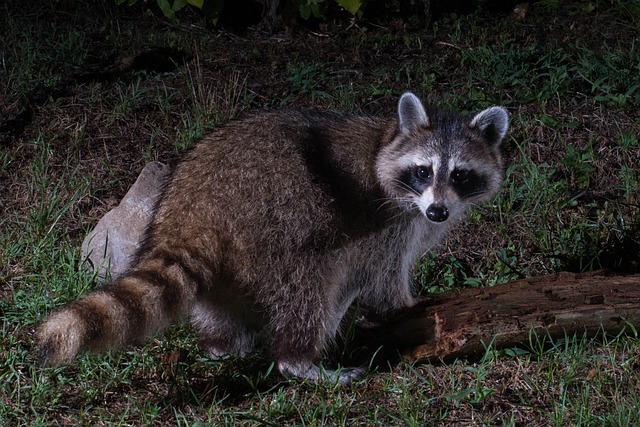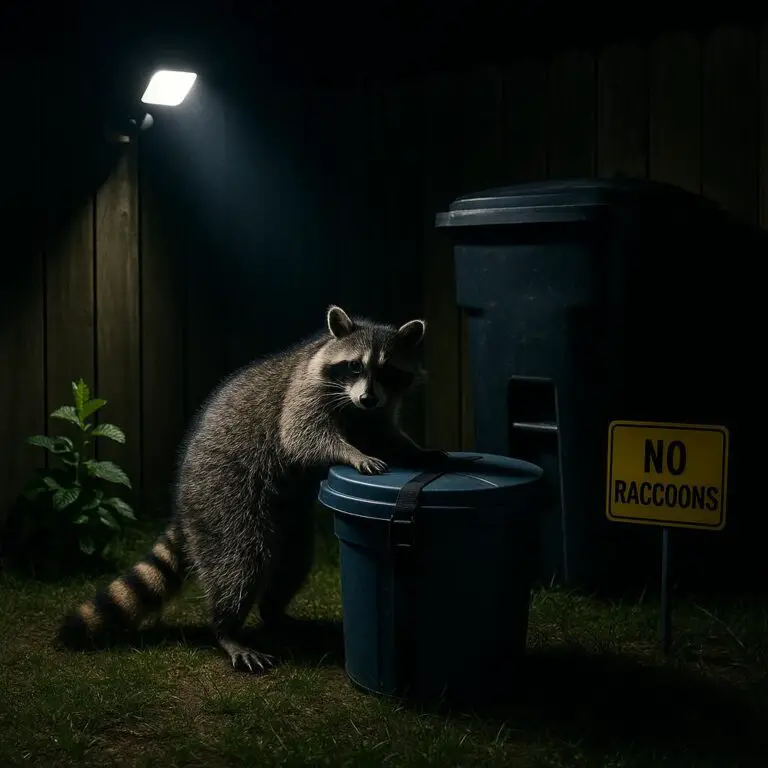If you ever wondered how far raccoons travel during their night escapades you’re not alone. Raccoons have always held a certain enigmatic charm, and their nighttime adventures have piqued the interest of many.
Raccoons typically travel an average of 2 to 5 miles (3 to 8 kilometers) in a single night. However, this range can vary due to factors like season, habitat, age, gender, and population density.
In this article, I’m excited to dive deep into the world of raccoons and explore the fascinating question: “How far do raccoons travel in a night?” I’ll uncover the secrets of raccoon behavior, the factors that influence their travels, the methods researchers use to study them, and the intriguing findings that have emerged from these studies.
Let’s get to it!
Understanding Raccoon Behavior
Before I start mapping out the nightly journeys of raccoons, it’s essential to get to know these creatures a bit better. Raccoons, scientifically known as Procyon lotor, are a common sight in many parts of North America. They are intriguing creatures known for their cleverness, adaptability, and distinctive masked faces.
Nocturnal Nature: One of the key aspects of raccoon behavior is their nocturnal lifestyle. While most of us are winding down for the night, raccoons are just getting started. These clever critters are most active during the darkness, which is when they venture out to forage, explore, and interact.
Omnivorous Appetite: Raccoons aren’t picky eaters. They have a reputation for being omnivores, which means they’ll munch on just about anything they can find. Their diet includes fruits, vegetables, insects, small animals, and even the contents of your trash can. This adaptable eating habit is one reason they can thrive in various environments.
Intelligence and Adaptability: Raccoons are remarkably intelligent creatures. They can solve puzzles, open simple locks, and navigate complex urban landscapes. Their ability to adapt to changing circumstances has allowed them to thrive in both natural and human-altered environments.
Now that you have a basic understanding of raccoon behavior, let’s dig deeper into the factors that influence how far they travel in a single night.
Factors Influencing Raccoon Travel Distances
Raccoons are certainly fascinating creatures, but their nightly wanderings aren’t entirely random. Several factors play a significant role in determining how far they travel during the dark hours. Let’s take a closer look at these factors:
1. Seasonality: Raccoon travel distances can vary dramatically throughout the year due to the changing seasons.
- Mating Season: During the mating season, which typically occurs in late winter or early spring, raccoons may travel more extensively in search of potential mates. This is a time when they can cover greater distances as they seek out partners.
- Winter Hibernation: In the colder months, raccoons tend to hunker down and conserve energy by reducing their movements. While they may still venture out in search of food, their travel distances are generally shorter during winter.
2. Habitat and Resources: The availability of food and suitable shelter strongly influences raccoon travel patterns.
- Abundant Food Sources: Raccoons are opportunistic feeders, and the presence of ample food sources in a particular area can limit their need to travel extensively. If they find a neighborhood with easily accessible trash cans or abundant natural food, they may stick around rather than roam far and wide.
- Shelter and Nesting Sites: The availability of safe shelter and nesting sites can also impact their travel distances. Raccoons tend to establish dens in tree hollows, burrows, or even attics. If they find a suitable home base, they might not travel as far each night.
3. Age and Gender: Age and gender can also be influential factors.
- Young Raccoons: Young raccoons, or kits, often travel shorter distances because they are more vulnerable and less experienced than adult raccoons. They tend to stay closer to their den until they grow older and more self-reliant.
- Female Raccoons: Female raccoons with babies (kits) tend to have shorter travel ranges, as they prioritize caring for and protecting their young. This maternal instinct keeps them closer to their den sites.
- Male Raccoons: Adult male raccoons typically travel farther, especially during the mating season when they seek out females. Their journeys can cover several miles in a single night.
Understanding these factors provides valuable insights into the dynamic world of raccoon travel. It’s not just about how far they go; it’s about why and when they decide to embark on these nocturnal adventures.
Methods of Studying Raccoon Movements
So, how do researchers go about uncovering the secrets of raccoon travel distances in the darkness of the night? It’s no small feat, but modern science offers some ingenious methods to track these masked wanderers. Here are some of the key techniques researchers use:
1. Radio Telemetry
Radio telemetry involves attaching small radio transmitters to raccoons. These transmitters emit radio signals that researchers can track using specialized receivers. This method allows scientists to monitor the movements of raccoons in real-time, even in areas with dense vegetation or when they are hidden in urban environments.
2. GPS Tracking
In recent years, GPS technology has revolutionized the study of raccoon behavior. Researchers can attach GPS collars to raccoons, which periodically record the animal’s location. These collars are often programmed to drop off after a certain period, allowing researchers to retrieve the data and analyze the raccoon’s movements over time accurately.
3. Camera Traps
Camera traps are another valuable tool in the wildlife researcher’s toolkit. These motion-activated cameras are strategically placed in raccoon habitats. When a raccoon passes by, the camera takes a photo or records video, providing valuable visual data on their movements and behavior.
4. Scat Analysis
Yes, you read that right – raccoon poop can be a source of information! By analyzing the contents of raccoon scat (feces), researchers can gain insights into their diet and, indirectly, their movements. Different food items, such as berries, insects, or small mammals, can reveal what raccoons have been foraging for and where.
5. Hair Traps
Hair traps are non-invasive and ethical methods to study raccoon movements. Researchers set up wire brushes or other devices that collect hair samples from raccoons as they pass through. These samples can then be analyzed for DNA, providing information about individual raccoons’ movements and genetic diversity in a population.
6. Observational Studies
Sometimes, the best way to understand raccoon behavior is simply to observe it. Researchers may spend countless hours in the field, watching raccoons from a distance using night-vision equipment. This method allows for a more comprehensive understanding of their natural behavior.
By using a combination of these methods, researchers can piece together a comprehensive picture of raccoon movements, helping us answer the question of how far they travel in a night.
Research Findings
Now that you’ve explored the methods researchers employ to study raccoon movements, it’s time to unveil some of the intriguing findings that have emerged from these studies. Let’s take a closer look at what science has uncovered about how far raccoons travel during their nightly adventures:
A. Average Nightly Travel Distances
Researchers have discovered that raccoon travel distances can vary widely based on factors like location and habitat. On average, raccoons are known to cover distances ranging from 2 to 5 miles (3 to 8 kilometers) during a single night of foraging. However, it’s important to note that this range can be much smaller or larger depending on the availability of food and other resources.
B. Seasonal Variations
Spring and Summer: During the warmer months, raccoons tend to travel shorter distances, often staying within a 1 to 2-mile radius of their den sites. This is because food sources are more abundant, and they don’t need to roam as far to find sustenance.
Fall and Winter: As autumn sets in and winter approaches, raccoons become more mobile. They may venture farther from their den sites, sometimes covering 5 miles or more in a single night. This is partly due to the need to find food before it becomes scarcer in the winter months.
C. Gender Differences
Male raccoons, especially during the mating season, tend to travel greater distances than females. Some studies have reported male raccoons traveling up to 10 miles (16 kilometers) in search of potential mates. Female raccoons, on the other hand, typically stay closer to their den sites, especially when caring for their young.
D. Urban vs. Rural Environments
Raccoons have shown remarkable adaptability to urban environments. In cities and suburbs, where food sources are more accessible (think trash cans and pet food), raccoons may have smaller home ranges compared to their rural counterparts. Urban raccoons have been observed traveling as little as a mile or less in a night.
E. Population Density
In areas with high raccoon population densities, individual raccoons may have smaller home ranges. Conversely, in regions with lower population densities, raccoons might need to cover more ground to find food and other resources.
These findings underscore the dynamic and adaptable nature of raccoons’ nightly travels. Their movements are not only influenced by biological factors but also by the ever-changing conditions of their environment.
Interesting Raccoon Travel Stories
Raccoons, with their resourcefulness and nocturnal escapades, have certainly left their mark on the annals of wildlife lore. Here are a few captivating tales of raccoon journeys that highlight their remarkable abilities:
1. The Suburban Scavenger
In a quiet suburban neighborhood, a particularly clever raccoon earned a reputation as the “masked bandit” for its nightly escapades into residents’ trash cans. It was reported that this raccoon could navigate even the most complex trash can locks with ease, leaving a trail of scattered garbage in its wake. Local residents marveled at its persistence and problem-solving skills, and it became a symbol of urban adaptability.
2. The Nighttime Navigator
In a research study using GPS tracking, a male raccoon in a rural area was found to cover an astonishing 10 miles (16 kilometers) in a single night during the mating season. This raccoon’s journey took it through fields, forests, and even a small river. Such long-distance travel demonstrated the determination of raccoons when it comes to finding potential mates.
3. The City Park Explorer
In a bustling city with a large park, a group of raccoons had established their territory. Researchers observed one raccoon from this group that regularly explored the city park at night. It became known as the “park explorer.” This raccoon’s nightly journeys covered a range of habitats, from densely wooded areas to open fields, showcasing their adaptability to urban environments.
4. The Family’s Hidden Den
A mother raccoon with her young kits was discovered living in the attic of a suburban home. While she occasionally ventured out to find food, her travel distances were relatively short. What was most fascinating about this story was the maternal instinct of the mother raccoon, who carefully protected her kits and kept them hidden in the safe confines of the attic den.
These stories offer a glimpse into the diverse and intriguing lives of raccoons. From urban scavengers to long-distance travelers, raccoons exhibit a wide range of behaviors that continue to captivate researchers and wildlife enthusiasts alike. As we explore further, let’s consider the practical implications of understanding raccoon behavior, especially in our interactions with these resourceful creatures.
Practical Implications
Understanding the nightly travels of raccoons isn’t just a fascinating scientific pursuit; it also has practical implications for both wildlife conservation and coexisting peacefully with these clever creatures. Here are some key takeaways:
1. Wildlife Conservation
- Preservation of Habitat: Recognizing the factors that influence raccoon movements can inform conservation efforts. Protecting their natural habitats ensures they have the resources they need to thrive.
- Management of Urban Areas: Urban planners and wildlife management agencies can use knowledge of raccoon behavior to minimize conflicts between humans and raccoons. This includes securing trash cans, addressing issues of food availability, and creating wildlife-friendly urban spaces.
2. Health and Safety
- Disease Transmission: Raccoons can carry diseases like rabies and distemper. Understanding their movement patterns helps identify potential disease hotspots and implement measures to mitigate risks, such as vaccinating pets and avoiding contact with wild raccoons.
- Vehicle Collisions: In areas where raccoons are known to travel, drivers should be alert, especially during their peak activity hours at night, to reduce the risk of collisions.
3. Responsible Behavior Around Raccoons
- Avoid Feeding Raccoons: Feeding raccoons intentionally or unintentionally by leaving pet food outside can lead to habituation and unhealthy dependency on human-provided food.
- Secure Trash and Food: Properly securing trash cans and storing pet food indoors can discourage raccoons from becoming a nuisance in urban areas.
- Respect Their Space: If you encounter raccoons in the wild, keep a safe distance and do not approach or attempt to feed them. Raccoons, though curious, can become defensive if they feel threatened.
- Humane Solutions: If raccoons become a persistent problem in your area, consider contacting local wildlife experts or animal control for guidance on humane and ethical solutions to manage conflicts.
By recognizing the practical implications of understanding raccoon behavior, we can foster a harmonious coexistence between these intelligent creatures and our urban environments. It’s a delicate balance that requires both appreciation for the wonders of wildlife and responsible stewardship of our shared spaces.
Conclusion
In conclusion, how far do raccoons travel in a night? It’s a bit like asking how long a piece of string is – it varies. On average, raccoons cover distances ranging from 2 to 5 miles (3 to 8 kilometers) in a single night. However, this range can be influenced by a multitude of factors, including the season, habitat, age, gender, and population density.
Understanding raccoon behavior isn’t just about satisfying our curiosity; it has practical implications for wildlife conservation and harmonious coexistence. you’ve learned that protecting their natural habitats, managing urban areas responsibly, and respecting their space are key to ensuring raccoons thrive alongside us.
As you conclude this exploration, please carry this newfound appreciation for these resourceful and adaptable creatures. In the moonlit nights to come, when you spot those gleaming eyes in the darkness, remember that raccoons are more than just travelers of the night; they are our fellow inhabitants of this shared world, worthy of our respect and protection.
Additional Resources
If you’ve been captivated by the world of raccoons and want to dive deeper into their behavior, conservation, and coexistence, here are some valuable resources to explore:
Books:
- “Raccoons: A Natural History” by Samuel I. Zeveloff – Provides an in-depth look at raccoon biology, behavior, and their role in ecosystems.
- “Raccoon Family Secrets” by Barbara A. Wolfram – Offers a closer look at the family life and social behaviors of raccoons.
Websites and Organizations:
- National Wildlife Federation (NWF) – The NWF’s website has a wealth of information on raccoons, including tips for wildlife-friendly gardening and coexisting with raccoons in urban areas.
- The Humane Society of the United States – Their website provides guidance on humane raccoon control and tips for resolving conflicts with these creatures.
- Your Local Wildlife Rehabilitation Center – Many regions have wildlife rehabilitation centers that can provide advice and resources specific to your area. Look up one in your region to learn more about raccoons and other local wildlife.
- University Wildlife Biology Departments – Universities often conduct research on local wildlife, including raccoons. Check the websites of nearby universities for valuable research and insights.
Here’s another great article you may want to read next: How Far Away Can Raccoons Smell Food?








